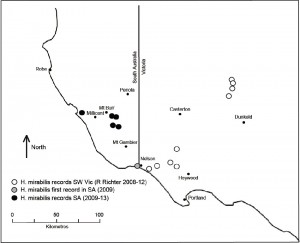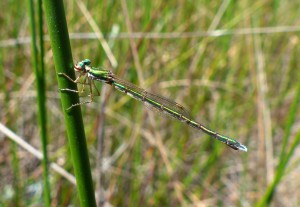Introducing NGT’s ‘species of the month’ – Jan 2015 – Ancient greenling
In recognition of the amazing diversity of plants and animals in Australia, some of which we have the fortunate opportunity to study and help conserve, we have introduced a ‘species of the month’ blog.
Fittingly we kick off with NGT’s logo, the ancient greenling Hemiphlebia mirabilis
The ancient greenling is a tiny damselfly species (wingspan up to 2.2cm) of feeble flight and dispersal capabilities that prefers floodplain and coastal wetlands, often those dry seasonally. It is usually dark metallic green above and white below (on the head and thorax, with a white appendage at the base of the tail that can be observed at rest. A characteristic of this species is the curling/flicking of its tail up and down while perched (although its not doing it in the photo on the left!), a behaviour not observed in other damselflies in South Australia. Currently the Ancient Greenling is not protected by legislation (National Parks and Wildlife Act, 1972) within South Australia but is listed under the Flora and Fauna Guarantee Act, 1988 in Victoria.

Recent records of ancient greenling in southeast South Australia and southwest Victoria (note: over December 2014 and January 2015 additional sightings occurred the Marshes Native Forest Reserve and Lake Frome Conservation Park).
Regionally, a new population of the species was discovered in Long Swamp in December 2008 and during the following December (2009) the first observation occurred for South Australia from the Piccaninnie Ponds Karst Wetland – flying in a Twig-rush Baumea arthrophylla swamp fringed with tea-tree (Melaleuca squarrosa and Leptospermum lanigerum) and was quite abundant. Subsequent observations have occurred in SA at sites up to 60 km further north-west along the coast and as far-inland as the Mount Burr Range, and even further inland in the Grampians in Victoria – expanding our previous knowledge of the species distribution.
For more info, see:
Haywood, B. T. and Richter, R. (2013). The Ancient Greenling Hemiphlebia mirabilis (Odonata:Hemiphlebiidae) in South Australia. South Australian Naturalist, 87, 42-47.
Richter, R. (2009). Discovery of New Population of Hemiphlebia mirabilis (Ancient Greenling). Victorian Entomologist, 39 (2): 27–29.
Interesting fact: Its two-part name comes from (a) the fact that it is considered a species of ‘living fossil’ that retains ancient features, and (b) the stunning metallic green colouration of its body.


